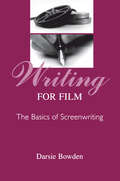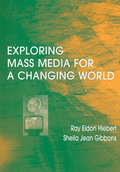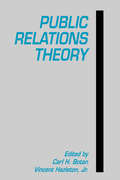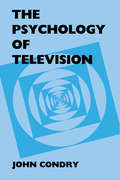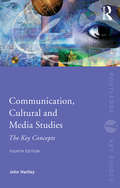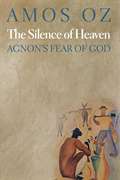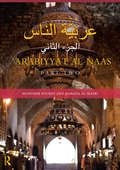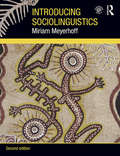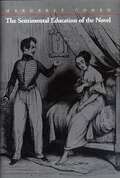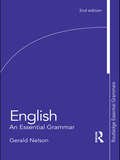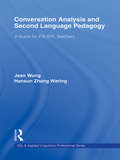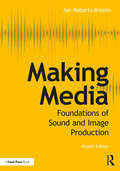- Table View
- List View
Landmark Essays on Writing Centers: Volume 9 (Landmark Essays Series)
by Christina Murphy Joe LawThis collection introduces the reader to the ideas that have shaped writing center theory and practice. The essays have been selected not only for the insight they offer into issues but also for their contributions to writing center scholarship. These papers help to chart the legitimation of writing centers by providing both a history and an examination of the philosophies, praxis, and politics that have defined this emerging field. They demonstrate the ways a clearer profile of the discipline has emerged from the research and reflection of writers, like those represented here. This volume charts the emergence of writing centers and the growing recognition of their contributions, roles, and importance. As a nascent discipline, writing centers reflect the concerns with marginality and with finding a respected place in the academy that characterize any new field of academic inquiry, practice, and research. Concomitantly, professionals in these fields seek standing within the academy and a way of defining and validating their contributions to the educational process. Contemporary writing center theorists look to interdisciplinary and multidisciplinary investigations to interpret the work they do and to clarify their aims to the academy at large. Their work employs a variety of philosophical perspectives -- ranging from sociolinguistics to psychoanalytic theory -- to show the complex nature and potential of writing center interactions. The idea has now become the multidimensional realities of the writing center within the academy and within society as a whole. What its role will be in future redefinitions of the educational process, how that role will be negotiated and evaluated, and how professionals will shape educational values will constitute the future landmark directions and essays on writing center theory and practice.
Landmark Essays on ESL Writing: Volume 17 (Landmark Essays Series #Vol. 17)
by Tony Silva Paul Kei MatsudaIn recent years, the number of nonnative speakers of English in colleges and universities in North America has increased dramatically. As a result, more and more writing teachers have found themselves working with these English as a Second Language (ESL) students in writing classes that are designed primarily with monolingual, native-English-speaking students in mind. Since the majority of institutions require these students to enroll in writing courses at all levels, it is becoming increasingly important for all writing teachers to be aware of the presence and special linguistic and cultural needs of ESL writers. This increase in the ESL population has, over the last 40 years, been paralleled by a similar growth in research on ESL writing and writing instruction--research that writing teachers need to be familiar with in order to work effectively with ESL writers in writing classrooms of all levels and types. Until recently, however, this body of knowledge has not been very accessible to writing teachers and researchers who do not specialize in second language research and instruction. This volume is an attempt to remedy this problem by providing a sense of how ESL writing scholarship has evolved over the last four decades. It brings together 15 articles that address various issues in second language writing in general and ESL writing in particular. In selecting articles for inclusion, the editors tried to take a principled approach. The articles included in this volume have been chosen from a large database of publications in second language writing. The editors looked for works that mirrored the state of the art when they were published and made a conscious effort to represent a wide variety of perspectives, contributions, and issues in the field. To provide a sense of the evolution of the field, this collection is arranged in chronological order.
Landmark Essays on ESL Writing: Volume 17 (Landmark Essays Series)
by Tony Silva Paul Kei MatsudaIn recent years, the number of nonnative speakers of English in colleges and universities in North America has increased dramatically. As a result, more and more writing teachers have found themselves working with these English as a Second Language (ESL) students in writing classes that are designed primarily with monolingual, native-English-speaking students in mind. Since the majority of institutions require these students to enroll in writing courses at all levels, it is becoming increasingly important for all writing teachers to be aware of the presence and special linguistic and cultural needs of ESL writers. This increase in the ESL population has, over the last 40 years, been paralleled by a similar growth in research on ESL writing and writing instruction--research that writing teachers need to be familiar with in order to work effectively with ESL writers in writing classrooms of all levels and types. Until recently, however, this body of knowledge has not been very accessible to writing teachers and researchers who do not specialize in second language research and instruction. This volume is an attempt to remedy this problem by providing a sense of how ESL writing scholarship has evolved over the last four decades. It brings together 15 articles that address various issues in second language writing in general and ESL writing in particular. In selecting articles for inclusion, the editors tried to take a principled approach. The articles included in this volume have been chosen from a large database of publications in second language writing. The editors looked for works that mirrored the state of the art when they were published and made a conscious effort to represent a wide variety of perspectives, contributions, and issues in the field. To provide a sense of the evolution of the field, this collection is arranged in chronological order.
Writing for Film: The Basics of Screenwriting
by Darsie BowdenIn this introduction to screenwriting, author Darsie Bowden provides sage, real-world advice and instruction on the process of writing film screenplays. This text will help budding screenwriters to structure their dramas, refine their characterizations, and craft their language, while also introducing them to the appropriate screenplay formats. It covers the complexities of writing for the screen and points out the contradictions to expect if readers pursue this work as a career. In addition to covering the elements of the dramatic film screenplay, Bowden discusses writing for such "alternative" markets as documentaries, independent films, experimental films, and other non-Hollywood options. Features of the text include:guidelines for working as a screenwriter;applications and exercises to enhance skills;suggested readings for further development; anda comprehensive list of resources for screenwriting.Successful writing for film lies in being able to heighten one's perceptive abilities about the world and to communicate those perceptions in a cinematic way. In this text, Bowden introduces readers to an approach to screenwriting that will help them see the world in a different way and write about it using different genres and media. This most valuable skill prepares readers for the range of possibilities they will encounter on the path to successful screenwriting.
Exploring Mass Media for A Changing World
by Ray A Hiebert Sheila GibbonsBeautifully written and class tested, Exploring Mass Media for a Changing World provides a comprehensive but modestly priced text around which instructors can develop a customized teaching package. Written for introductory courses, it covers essential information students need in order to understand the media, the mass communication process, and the role of media in society. It summarizes basic, generally agreed-upon principles, theories, significant historical events, and essential facts, but does so in a tightly written, readable style. Taken together, this information can be thought of as a minimum repertoire that all citizens of the "information age" need in order to become literate consumers and users of mass communication. Features include: *Historical Framework--For ease of comprehension, media processes and individual media are placed in historical context to show their technological evolution and the effects of those changes on society. *Organization--The first seven chapters deal with the evolution of communication theories and processes common to all media. The next five deal with specific media in the chronological order in which they became mass media. Chapters 13 and 14 introduce two non-media institutions (advertising and public relations) whose exploration is essential in order to understand how mass media functions in our society. Finally, chapter 15 returns to the theme of technological evolution and its effects on society with an in-depth discussion of the internet. *Flexibility--Because it is concise, affordable, and comprehensive, it can be used either as a stand-alone text in mass media courses or as part of an instructional package in courses where mass communication is one of several major units. *Themes--The following themes are introduced early and carried throughout: (a) the evolution of media technology and its effects on society, (b) the global and culture-bound characteristics of mass media, and (c) the need for media literacy in the 21st century. *Supplements--An accompanying instructor's manual begins with a chapter-length essay on teaching the mass media course then offers the following items for each chapter: topical outline and key vocabulary; key ideas to be emphasized and pitfalls to be avoided; discussion questions; objective and essay test items; and both print and nonprint resources for further study.
Public Relations Theory
by Carl H. BotanBeginning with the basic premise that public relations can best be understood as a specialized type of communication, the contributors to this volume establish public relations as a vital and viable realm for communication research and theory development. Through the application of communication theories, they attempt to explain and predict public relations practices and then use these practices to develop communication theories. Their discussions fall into three distinct categories: metatheory, theory, and examples of applications of theories. An ideal volume for professionals and students in communication, journalism, and related fields.
The Psychology of Television
by John CondryThis volume addresses the content of television -- both programs and advertisements -- and the psychological effects of the content on the audience. The author not only reports new research, but explains its practical applications without jargon. Issues are discussed and described in terms of psychological mechanisms and causal routes of influence. While primarily referring to the American television industry and American governmental regulations, the psychological principles discussed are applicable to television viewers world wide.
Communication, Cultural and Media Studies: The Key Concepts (Routledge Key Guides)
by John HartleyThis fourth edition of Communication, Cultural and Media Studies: The Key Concepts is an indispensible guide to the most important terms in the field. It offers clear explanations of the key concepts, exploring their origins, what they’re used for and why they provoke discussion. The author provides a multi-disciplinary explanation and assessment of the key concepts, from ‘authorship’ to ‘censorship’; ‘creative industries’ to ‘network theory’; ‘complexity’ to ‘visual culture’. The new edition of this classic text includes: Over 200 entries including 50 new entries All entries revised, rewritten and updated Coverage of recent developments in the field Insight into interactive media and the knowledge-based economy A fully updated bibliography with 400 items and suggestions for further reading throughout the text
Communication, Cultural and Media Studies: The Key Concepts (Routledge Key Guides)
by John HartleyThis fourth edition of Communication, Cultural and Media Studies: The Key Concepts is an indispensible guide to the most important terms in the field. It offers clear explanations of the key concepts, exploring their origins, what they’re used for and why they provoke discussion. The author provides a multi-disciplinary explanation and assessment of the key concepts, from ‘authorship’ to ‘censorship’; ‘creative industries’ to ‘network theory’; ‘complexity’ to ‘visual culture’. The new edition of this classic text includes: Over 200 entries including 50 new entries All entries revised, rewritten and updated Coverage of recent developments in the field Insight into interactive media and the knowledge-based economy A fully updated bibliography with 400 items and suggestions for further reading throughout the text
Readings in Classical Rhetoric
by Thomas W. Benson Michael H. ProsserRhetoric -- the theory of oral discourse -- affected and indeed pervaded all aspects of classical thought. Bearing the stamp of its impact were the Homeric hymns, the Iliad and the Odyssey, Aeschylus' Eumenides, the great dramatic tragedies, the elegiac and lyric poetry, and the literature of the Romans, often formed in the Greek image. The rhetorical notion of probability had direct implications for the classical philosopher and mathematician as it does today. Departments of speech, English, philosophy and classics provide the key centers of interest in the new and the classical rhetorics. Despite the considerable enthusiasm for the study of rhetoric, no single work provides large selections of primary materials written by the classical rhetoricians themselves. Until now, only secondary sources containing tiny excerpts, or entire and expensive translations of the ancient rhetorical writings were available. This large anthology of primary readings of the classical rhetoricians in translation fills this large gap. The continuity and coherence of ancient rhetorical traditions is emphasized by organizing large excerpts into the topical divisions that later classical writers agreed upon. The first unit of this anthology sets forth major issues in the definition and scope of rhetoric, and its appropriate place among other modes of thought and discourse. Parts 2 through 5 are organized according to the traditional canons of oratory -- invention, disposition, style, memory, and delivery. In organizing the readings this way, the editors represent both the philosophical and theoretical issues in rhetoric and its pragmatic functions as a craft for making effective discourse. Selecting excerpts that illustrate the major conflicts within the unfolding tradition enables a sampling of not only the major points of view, but also the arguments supporting them. This volume includes selections not only from writings of the standard classical rhetoricians but also from less typical works which have special value. The editors have utilized the best accessible translations while remaining absolutely faithful to their texts.
The Powers of Distance: Cosmopolitanism and the Cultivation of Detachment (PDF)
by Amanda AndersonCombining analysis of Victorian literature and culture with forceful theoretical argument, The Powers of Distance examines the progressive potential of those forms of cultivated detachment associated with Enlightenment and modern thought. Amanda Anderson explores a range of practices in nineteenth-century British culture, including methods of objectivity in social science, practices of omniscience in artistic realism, and the complex forms of affiliation in Victorian cosmopolitanism. Anderson demonstrates that many writers--including George Eliot, John Stuart Mill, Charlotte Brontë, Matthew Arnold, and Oscar Wilde--thoughtfully address the challenging moral questions that attend stances of detachment. In so doing, she offers a revisionist account of Victorian culture and a tempered defense of detachment as an ongoing practice and aspiration. The Powers of Distance illuminates its historical object of study and provides a powerful example for its theoretical argument, showing that an ideal of critical detachment underlies the ironic modes of modernism and postmodernism as well as the tradition of Enlightenment thought and critical theory. Its broad understanding of detachment and cultivated distance, together with its focused historical analysis, will appeal to theorists and critics across the humanities, particularly those working in literary and cultural studies, feminism, and postcolonialism. Original in scope and thesis, this book constitutes a major contribution to literary history and contemporary theory.
Rereading the Stone: Desire and the Making of Fiction in <i>Dream of the Red Chamber</i>(PDF)
by Anthony C. YuThe eighteenth-century Hongloumeng, known in English as Dream of the Red Chamber or The Story of the Stone, is generally considered to be the greatest of Chinese novels--one that masterfully blends realism and romance, psychological motivation and fate, daily life and mythical occurrences, as it narrates the decline of a powerful Chinese family. In this path-breaking study, Anthony Yu goes beyond the customary view of Hongloumeng as a vivid reflection of late imperial Chinese culture by examining the novel as a story about fictive representation. Through a maze of literary devices, the novel challenges the authority of history as well as referential biases in reading. At the heart of Hongloumeng, Yu argues, is the narration of desire. Desire appears in this tale as the defining trait and problem of human beings and at the same time shapes the novel's literary invention and effect. According to Yu, this focalizing treatment of desire may well be Hongloumeng's most distinctive accomplishment. Through close readings of selected episodes, Yu analyzes principal motifs of the narrative, such as dream, mirror, literature, religious enlightenment, and rhetorical reflexivity in relation to fictive representation. He contextualizes his discussions with a comprehensive genealogy of qing--desire, disposition, sentiment, feeling--a concept of fundamental importance in historical Chinese culture, and shows how the text ingeniously exploits its multiple meanings. Spanning a wide range of comparative literary sources, Yu creates a new conceptual framework in which to reevaluate this masterpiece.
Shades of the Planet: American Literature as World Literature (PDF)
by Wai Chee Dimock Lawrence BuellIn a globalizing age, studying American literature in isolation from the rest of the world seems less and less justified. But is the conceptual box of the nation dispensable? And what would American literature look like without it?Leading scholars take up this debate in Shades of the Planet, beginning not with the United States as center, but with the world as circumference. This reversed frame yields a surprising landscape, alive with traces of West Africa, Eastern Europe, Iran, Iraq, India, China, Mexico, and Australia. The Broadway musical Oklahoma! has aboriginal antecedents; Black English houses an African syntax; American slavery consorts with the Holocaust; Philip Roth keeps company with Milan Kundera; the crime novel moves south of the border; and R. P. Blackmur lectures in Japan. A national literature becomes haunted by the world when that literature is seen extending to the Pacific, opening up to Islam, and accompanying African-American authors as they travel. Highlighting American literature as a fold in a planet-wide fabric, this pioneering volume transforms the field, redrawing its institutional as well as geographical map.The contributors are Rachel Adams, Jonathan Arac, Homi K. Bhabha, Lawrence Buell, Wai Chee Dimock, Susan Stanford Friedman, Paul Giles, David Palumbo-Liu, Ross Posnock, Joseph Roach, and Eric J. Sundquist.
The Silence of Heaven: Agnon's Fear of God (PDF)
by Amos OzIn The Silence of Heaven, the world renowned Israeli novelist Amos Oz introduces us to an extraordinary masterpiece of Hebrew literature that is just now appearing in English, S. Y. Agnon's Only Yesterday. For Oz, Agnon is a treasure trove of a world no longer available to today's writers, yet deeply meaningful for his wonderment about God, the submerged eroticism of his writing, and his juggling of multiple texts from the historical Hebrew religious library. This collection of Oz's reflections on Agnon, which includes an essay on the essence of his ideology and poetics, is a rich interpretive work that shows how one great writer views another. Oz admires Agnon especially for his ability to invoke and visualize the religious world of the simple folk in Eastern European Jewry, looking back from the territorial context of the Zionist revival in Palestine. The tragedy of Agnon's visions, Oz maintains, lies in his perspicacity. Long before the Holocaust, Agnon saw the degeneration, ruin, and end of Jewish culture in Eastern Europe. He knew, too, that the Zionist project was far from being a secure conquest and its champions far from being happy idealists. Oz explores these viewpoints in a series of thick readings that consider the tensions between faith and the shock of doubt, yearnings and revulsion, love and hate, and intimacy and disgust. Although Oz himself is interested in particular ideological questions, he has the subtle sensibility of a master of fiction and can detect every technical device in Agnon's arsenal. With the verve of an excited reader, Oz dissects Agnon's texts and subtexts in a passionate argument about the major themes of Hebrew literature. This book also tells much about Oz. It represents the other side of Oz's book of reportage, In the Land of Israel, this time exploring the ideologies of Jewish identity not on the land but in texts of the modern classical heritage. The Silence of Heaven hence takes us on a remarkable journey into the minds of two major literary figures.
Twice upon a Time: Women Writers and the History of the Fairy Tale (PDF)
by Elizabeth Wanning HarriesFairy tales, often said to be ''timeless'' and fundamentally ''oral,'' have a long written history. However, argues Elizabeth Wanning Harries in this provocative book, a vital part of this history has fallen by the wayside. The short, subtly didactic fairy tales of Charles Perrault and the Grimms have determined our notions about what fairy tales should be like. Harries argues that alongside these ''compact'' tales there exists another, ''complex'' tradition: tales written in France by the conteuses (storytelling women) in the 1690s and the late-twentieth-century tales by women writers that derive in part from this centuries-old tradition. Grounded firmly in social history and set in lucid prose, Twice upon a Time refocuses the lens through which we look at fairy tales. The conteuses saw their tales as amusements for sophisticated adults in the salon, not for children. Self-referential, frequently parodic, and set in elaborate frames, their works often criticize the social expectations that determined the lives of women at the court of Louis XIV. After examining the evolution of the ''Anglo-American'' fairy tale and its place in this variegated history, Harries devotes the rest of her book to recent women writers--A. S. Byatt, Anne Sexton, Angela Carter, and Emma Donoghue among them--who have returned to fairy-tale motifs so as to challenge modern-day gender expectations. Late-twentieth-century tales, like the conteuses', force us to rethink our conception of fairy tales and of their history.
Arabiyyat al-Naas (Part Two): An Intermediate Course in Arabic (PDF)
by Munther Younes Hanada Al-MasriArabiyyat al Naas (Part Two): An Intermediate Course in Arabic offers a vibrant course in Arabic as it is written and spoken today by educated native speakers. Not only does it continue the innovative integration of Modern Standard Arabic (MSA) and Levantine Arabic used in Part One of the series, but it does so in a way that supports and develops students’ increased mastery of the language. Combining a greater focus on cultural topics with an increased coverage of MSA, Part Two introduces more sophisticated communication, giving students a deeper awareness of the cultural base of the Arabic language. Features include: Twenty-one theme-based units covering a wide range of relevant and engaging topics, including education and learning, jobs and professions, the Arab woman, religion, money and the economy, politics and government and the environment Thorough coverage of listening, speaking, writing and reading skills in every unit, with lessons structured to provide students with variety, stimulation and further opportunities for practice Humorous, realistic dialogues reflecting everyday educated speech among Arabs to build up strong and practical communication skills A rich variety of reading passages, including poems, short stories, newspaper articles, descriptions of Arab cities and biographies of famous figures, designed to improve comprehension and analytical skills and to deepen students’ knowledge of Arab history, culture, language, and literature An extensive range of appealing exercises and activities, including crossword puzzles, root-and-pattern identification exercises, passage completions, guided and free compositions, and songs Free accompanying CD that includes audio recordings of the listening materials in the 21 units and a number of songs tied to their themes Free companion website (www.routledge.com/cw/younes) featuring the texts of the listening passages, the audio recordings available on the CD , a track list of all the audio materials, the answer keys to the crossword puzzles, sample tests and language games. Developed by an experienced and dynamic author team and tested over a number of years at Cornell University, Arabiyyat al Naas (Part Two) will be an essential resource for intermediate-level students of Arabic. While primarily designed for classroom use, the accessibility of the course also renders it highly suitable for independent study. This volume is the second in a pioneering three-part series of Arabic textbooks which together provide a complete three-year undergraduate language program.
Introducing Sociolinguistics (PDF)
by Miriam MeyerhoffThis second edition of Miriam Meyerhoff’s highly successful textbook is supported by the Routledge Sociolinguistics Reader and online resources common to both books. It provides a solid, up-to-date appreciation of the interdisciplinary nature of the field covering foundation issues, recent advances and current debates. It presents familiar or classic data in new ways, and supplements the familiar with fresh examples from a wide range of languages and social settings. It clearly explains the patterns and systems that underlie language variation in use, as well as the ways in which alternations between different language varieties index personal style, social power and national identity. New features of the second edition: a wider range of approaches to politeness theory incorporating an international range of research expanded sections on multi-lingualism and code-switching, social class, dialect contact and tracking change over time linkage to the new Routledge Sociolinguistics Reader which can be used alongside this textbook, allowing students to supplement and build on material covered in the textbook. a shared website serving both Reader and Textbook which includes web- and video-links, interactive exercises and an expanded online glossary at: www.routledge.com/textbooks/meyerhoff a refreshed text design to assist navigation through textbook and reader. Each chapter includes exercises that enable readers to engage critically with the text, break-out boxes making connections between sociolinguistics and linguistic or social theory, and brief, lively add-ons guaranteed to make the book a memorable and enjoyable read. With a full glossary of terms and suggestions for further reading, this text gives students all the tools they need for an excellent command of sociolinguistics.
Language in the Real World: An Introduction to Linguistics
by Susan J. Behrens Judith A. ParkerLanguage in the Real World challenges traditional approaches to linguistics to provide an innovative introduction to the subject. By first examining the real world applications of core areas of linguistics and then addressing the theory behind these applications, this text offers an inductive, illustrative, and interactive overview for students. Key areas covered include animal communication, phonology, language variation, gender and power, lexicography, translation, forensic linguistics, language acquisition, ASL, and language disorders. Each chapter, written by an expert in the field, is introduced by boxed notes listing the key points covered and features an author’s note to readers that situates the chapter in its real world context. Activities and pointers for further study and reading are also integrated into the chapters and an end of text glossary is provided to aid study. Professors and students will benefit from the interactive Companion Website that includes a student section featuring comments and hints on the chapter exercises within the book, a series of flash cards to test knowledge and further reading and links to key resources. Material for professors includes essay and multiple choice questions based on each chapter and additional general discussion topics. Language in the Real World shows that linguistics can be appreciated, studied, and enjoyed by actively engaging real world applications of linguistic knowledge and principles and will be essential reading for students with an interest in language. Visit the Companion Website at www.routledge.com/textbooks/languagerealworld
The Sentimental Education of the Novel (PDF)
by Margaret CohenThe nineteenth-century French novel has long been seen as the heroic production of great men, who confronted in their works the social consequences of the French Revolution. And it is true that French realism, especially as developed by Balzac and Stendhal, was one of the most influential novelistic forms ever invented. Margaret Cohen, however, challenges the traditional account of the genesis of realism by returning Balzac and Stendhal to the forgotten novelistic contexts of their time. Reconstructing a key formative period for the novel, she shows how realist codes emerged in a "hostile take-over" of a prestigious contemporary sentimental practice of the novel, which was almost completely dominated by women writers. Cohen draws on impressive archival research, resurrecting scores of forgotten nineteenth-century novels, to demonstrate that the codes most closely identified with realism were actually the invention of sentimentality, a powerful aesthetic of emerging liberal-democratic society, although Balzac and Stendhal trivialized sentimental works by associating them with "frivolous" women writers and readers. Attention to these gendered struggles over genre explains why women were not pioneers of realism in France during the nineteenth century, a situation that contrasts with England, where women writers played a formative role in inventing the modern realist novel. Cohen argues that to understand how literary codes respond to material factors, it is imperative to see how such factors take shape within the literary field as well as within society as a whole. The book also proposes that attention to literature as a social institution will help critics resolve the current, vital question of how to practice literary history in the wake of poststructuralism.
English: An Essential Grammar (Routledge Essential Grammars)
by Gerald NelsonEnglish: An Essential Grammar is a concise and user-friendly guide to the grammar of modern English, written specifically for native speakers and based on genuine samples of contemporary spoken and written English. In the first four chapters, this book covers the essentials of English grammar, beginning with the basics and going on to deal with phrase, clause and sentence structure. A fifth chapter deals with English word formation and spelling, including problem spellings and British and American spelling variants. Features include: discussion of points that often cause problems guidance on sentence building and composition practical spelling guidelines explanation of grammatical terms a set of exercises at the end of each chapter appendix of irregular verbs. With numerous language examples bringing grammar to life, this Essential Grammar will help you read, speak and write English with greater confidence. It is ideal for everyone who would like to improve their knowledge of English grammar. Gerald Nelson is Professor in the English Department at The Chinese University of Hong Kong, and formerly Reader in the Department of English Language and Literature, University College London, UK.
English: An Essential Grammar (Routledge Essential Grammars)
by Gerald NelsonEnglish: An Essential Grammar is a concise and user-friendly guide to the grammar of modern English, written specifically for native speakers and based on genuine samples of contemporary spoken and written English. In the first four chapters, this book covers the essentials of English grammar, beginning with the basics and going on to deal with phrase, clause and sentence structure. A fifth chapter deals with English word formation and spelling, including problem spellings and British and American spelling variants. Features include: discussion of points that often cause problems guidance on sentence building and composition practical spelling guidelines explanation of grammatical terms a set of exercises at the end of each chapter appendix of irregular verbs. With numerous language examples bringing grammar to life, this Essential Grammar will help you read, speak and write English with greater confidence. It is ideal for everyone who would like to improve their knowledge of English grammar. Gerald Nelson is Professor in the English Department at The Chinese University of Hong Kong, and formerly Reader in the Department of English Language and Literature, University College London, UK.
Conversation Analysis and Second Language Pedagogy: A Guide for ESL/ EFL Teachers (ESL & Applied Linguistics Professional Series)
by Jean Wong Hansun Zhang WaringConversation and speaking skills are the key building blocks for much of language learning. This text increases teachers’ awareness about spoken language and suggests ways of applying that knowledge to teaching second-language interaction skills based on insights from Conversation Analysis (CA). Conversation Analysis and Second Language Pedagogy: reviews key CA concepts and findings directly connects findings from CA with second language pedagogy presents a model of interactional practices grounded in CA concepts includes numerous transcripts of actual talk invites readers to complete a variety of tasks to solidify and extend their understandings features a useful collection of practical teaching activities. The time is ripe for a book that blends conversation analysis and applied linguistics. This text takes that important step, extending the reaches of these once separate academic fields. Assuming neither background knowledge of conversation analysis nor its connection to second language teaching, it is designed for courses in TESOL and applied linguistics and as a resource for experienced teachers, material developers, and language assessment specialists seeking to update their knowledge and hone their craft.
Conversation Analysis and Second Language Pedagogy: A Guide for ESL/ EFL Teachers (ESL & Applied Linguistics Professional Series)
by Jean Wong Hansun Zhang WaringConversation and speaking skills are the key building blocks for much of language learning. This text increases teachers’ awareness about spoken language and suggests ways of applying that knowledge to teaching second-language interaction skills based on insights from Conversation Analysis (CA). Conversation Analysis and Second Language Pedagogy: reviews key CA concepts and findings directly connects findings from CA with second language pedagogy presents a model of interactional practices grounded in CA concepts includes numerous transcripts of actual talk invites readers to complete a variety of tasks to solidify and extend their understandings features a useful collection of practical teaching activities. The time is ripe for a book that blends conversation analysis and applied linguistics. This text takes that important step, extending the reaches of these once separate academic fields. Assuming neither background knowledge of conversation analysis nor its connection to second language teaching, it is designed for courses in TESOL and applied linguistics and as a resource for experienced teachers, material developers, and language assessment specialists seeking to update their knowledge and hone their craft.
Making Media: Foundations of Sound and Image Production
by Jan Roberts-BreslinMaking Media: Foundations of Sound and Image Production takes the media production process and deconstructs it into its most basic components. Students will learn the basic concepts of media production – frame, sound, light, time, motion, and sequencing – and be able to apply them to any medium they choose, from film and television to fine art and online applications. They will also become well-grounded in the digital work environment and the tools required to produce media in today’s digital environment. This new fourth edition is completely updated and includes a new chapter on the production process and production safety; information on current trends in production, exhibition, and distribution; and much more. New topics include virtual and augmented reality, the use of drones and new practices interactive media. The text is also fully illustrated and includes sidebar discussions of pertinent issues throughout. The companion website has been completely revamped with interactive exercises for each chapter, allowing students to explore the process of media production.
Victorian Women Poets (Longman Critical Readers)
by Tess CosslettThrough her selection of fourteen essays, Tess Cosslett charts the rediscovery by feminist critics of the Victorian Women Poets such as Emily Brontë, Elizabeth Barrett Browning and Christina Rossetti, and the subsequent developments as critics use a range of modern theoretical approaches to understand and promote the work of these non-canonical and marginalised poets. While the essays chosen for this volume focus on these three major figures, work is also included on less well-known poets who have only recently been brought into critical prominence. The introduction clarifies for the reader the themes, problems and preoccupations that inform the criticism and provides a useful guide to the debates surrounding poetry and feminism, investigating such questions as, how feminist are these poems, and does a women s tradition really exist? The advantages and disadvantages of applying different critical approaches, such as psychoanalytic and historicist, to the understanding of this period and genre are also fully explored.


